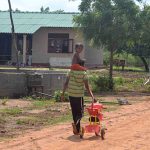Housing Crisis:
Tea Workers Living Like ‘Animals In A Stable’
Workers on tea plantations are the backbone of the Sri Lankan economy. Yet many live in cramped, ancient and dangerous houses.
Often you will find fourth or fifth generation families living in the line rooms built between the 1820s or up to 1857. Some of the rooves were attached in 1835 and are only held in place with heavy stones or bricks. The inhabitants often drape plastic sheets over the roof or over furnishings when it rains.
Some of the homes do not have running water and one feels as though the walls, many of which are cracked, could be pushed over, with a heavy shove. Electricity was only installed around five years ago and many of the houses are still lit by gas lights.
“This mud house is built on the same spot where an earlier one collapsed,” says K. Kumari, who lives on the Ensalwatta Estate in Sri Lanka’s Western Province. “We don’t have running water and we have to carry the water from nearby. If it rains hard then the walls collapse and we just have to build them again.”
“I am always here,” says Ramasamy Thangavelu, who also lives on the Ensalwatta Estate and who has been here since 1948 and still lives in the line rooms with his children and his grandchildren. “I don’t eat so much anymore because I don’t want the children to have to carry me to the toilet. I survive by drinking water,” notes Thangavelu, who likens his existence to prison.
/
There is no hospital here and there are other elderly people like Thangavelu in the dark rooms of the estate.
“We have never left the estate,” says B. Nallamma, a 59-year-old who lives in a house first built in 1854. “I didn’t go to school. And we eat rice once a day. New toys are just a dream for the children here,” she says.
The daily wage for an estate worker is SLR450 (about EUR2.75) and their monthly income can be as low as SLR2,500 (about EUR15), during a low harvest. So they don’t have enough money to leave the plantations anyway, let alone rent another house somewhere.
“These houses have not been repaired since 1989,” says Ariyadasa, an older woman who lives in a line room with cracked walls. “We have no rights and cannot alter the houses ourselves.”
Another woman living in the line rooms here, Alagar Walli Amma, shares her small accommodation with her six children; her husband is deceased. Amma likens her living conditions to a horse stable.
“I work every day yet my debts increase anyway,” Amma says. “I have to keep working but if I stop, what will happen to my children.”






